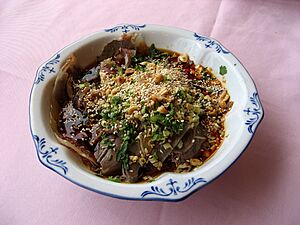Fuqi feipian facts for kids
Fuqi feipian is a very popular dish from the Sichuan region of China. It's usually served cold or at room temperature. This dish is made with thin slices of beef and other beef parts, like heart, tongue, and tripe (which is part of a cow's stomach).
The modern version of Fuqi feipian uses lots of different spices. One important spice is Sichuan pepper, which gives the dish its special taste. Just like many Sichuan dishes, Fuqi feipian is known for being both spicy and having a tingly, numbing feeling in your mouth. Even though its name means "husband and wife lung pieces," it almost never has actual lung in it today!
The History of Fuqi Feipian
The story of Fuqi feipian began a long time ago, during the late Qing dynasty in China. In the city of Chengdu, many street vendors would sell cold beef slices. They often used parts of the beef that were not as expensive, like beef offal (other parts of the animal besides the main meat). Because it was cheap, this dish was very popular with people who didn't have much money, like rickshaw drivers and students.
How the Dish Got Its Name
In the 1930s, a married couple in Chengdu became very famous for their beef slices. The husband, Guo Zhaohua, and his wife, Zhang Tianzheng, were very careful about how they made their dish. They often tried new ingredients to make it taste even better. Their beef slices tasted different and much better than what other vendors sold, so their business grew very quickly!
Sometimes, playful children would play a trick on the couple. They would stick paper notes on their backs that said fuqi feipian, which means "husband and wife lung pieces." People would even shout the words out loud!
One day, a rich merchant tried the couple's dish and loved it so much. He was so happy that he gave them a special plaque with the words fuqi feipian written in gold. After that, the name stuck, and everyone started calling the dish Fuqi feipian.
Changes Over Time
To make their customers even happier, the couple kept making improvements to their dish. Over time, they started using different kinds of beef or lamb slices instead of just offal. Many people still loved calling the dish fuqi feipian, so the name is still used today.
The word fei in the dish's name originally meant "waste parts" or "offal" (廢). But later, it was changed to mean "lung" (肺). This made the dish sound less strange or "repulsive" to people. Even though the name changed, actual lung is usually not a main ingredient in the dish.
See also
 In Spanish: Fuqi feipian para niños
In Spanish: Fuqi feipian para niños


